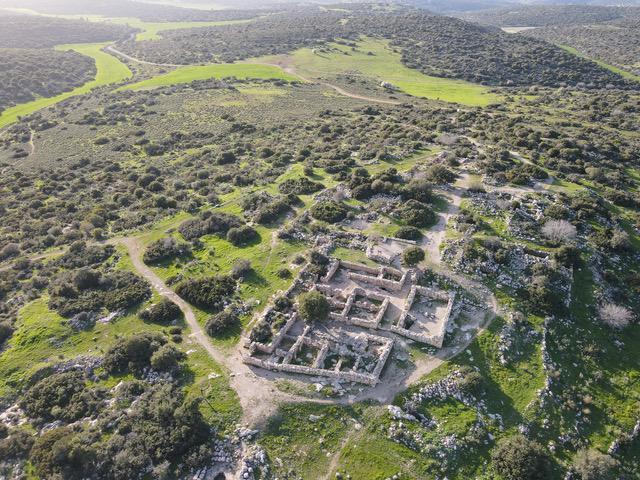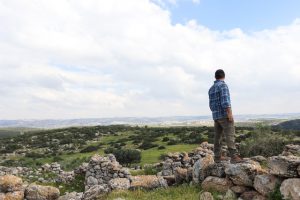April Travel Guide: Spring Beauty and Biblical History at Adulam Nature Reserve
Written by Susannah Schild
Jerusalem area travelers usually come to visit the holy sites, marketplaces, and cultural centers around the city. But just a short drive from the city in the Jerusalem Foothills, there’s a place with an entirely different sort of attraction: great natural beauty and rich history.
For both hikers and history lovers, the Adulam Grove Nature Reserve near Jerusalem is a place of enchantment. This large KKL (Keren Kayemeth LeYisrael – Jewish National Fund) Park is home to a hiking trail between two ancient Biblical towns: Burgin and Itri. These stone cities were built thousands of years ago, yet the walls of their homes still stand today. The ruins are a fascinating place to explore, filled with underground caves, ancient synagogues, and old ritual baths.
Adulam isn’t just for history buffs. During the months of January through April, the terrain at the Adulam Nature Reserve comes alive. In this season, winter rains transform usually dry terrain into a lush paradise of greenery and wildflowers. This makes April the perfect time to take a hike at Adulam. Along a six-kilometer loop trail in the park, hikers can take in all the beauty of springtime, while also exploring the incredible remnants of two Second Temple-era towns.

Hiking the Trail

The green marked trail at Adulam begins just beneath Itri Ruins. Here, hikers can walk past springtime meadows up a tree-covered hill towards the ancient city.
At the top, there’s plenty to explore. Just walking around above-ground, hikers can get a sense of the size and setup of the Second Temple town. There’s an easily accessible ritual bath, a great gathering room (once used as a synagogue), and plenty of small stone structures to explore between the spring flowers and greenery.
For those looking for a more in-depth adventure, there are awesome underground passageways to explore. With a headlamp to light the way, visitors can crawl on their hands and knees through dug-out tunnels from the time of the  Bar Kochva revolt, stopping along the way in larger, carved out rooms.
Bar Kochva revolt, stopping along the way in larger, carved out rooms.
After a thorough exploration, the trail leads out of Itri and through a world of springtime cheer. Along the path, wild mustard flowers blossom abundantly, along with daisies and wild herbs. Most of this six-kilometer loop trail is out in the sun, but there are plenty of large shady trees, which provide just enough shade for a mid-hike lunch break. One particularly beautiful carob tree is located midway between the two ancient towns.
The Next Great Adventure

After a pleasant walk through the reserve, the trail arrives at the second major attraction: Burgin Ruins. The remnants of the town at Burgin are much more vast and complete than those at Itri, as they were more recently settled. There are Byzantine-era burial caves, complete with carved stone columns bearing crosses. A Jewish burial cave is close by, with its own intricately carved entrance.
At Burgin, an old wine press and a columbarium gives insight into what the lives of the local residents must have been like. In this region, grapes and olives were grown for sustenance.
It can take hours to explore Burgin Ruins completely. Aside from all of the above-ground relics, there are also underground tunnels and caves at Burgin, dug out during the Jewish revolt against the Romans. During this time period, families retreated underground to hide from their Roman oppressors. Visitors to Burgin can go for a long crawl through these caves, and get a sense of what life may have been like for those who hid within long ago.
The Trail Continues

From Burgin, the green trail continues along a narrow pathway through more lush spring beauty. Hikers may encounter a flock of sheep or two as they walk, bringing this ancient landscape to life more completely. Aside from livestock, birds, bees, and butterflies also make their appearance along this trail, drawn to the area because of its colorful wildflowers and rich greenery.
After six kilometers of happy hiking, the loop trail ends back at the parking area below Itri Ruins.
Adulam in our History

There’s a lot of history to this nature reserve in the Jerusalem Foothills. During Biblical times, the area of Adulam was the clashing point between the mountain-dwelling Jews and the Philistines, who lived along the coastline. Many famous Biblical battles happened in this area.
From a high point in the park, one can see out to the ancient cities of Azeka and Socho (also mentioned in the Torah). David fought off Goliath, the Philistine giant in the valley just beneath these towns. Later, when King David fled from Saul, he used the caves in Adulam as a hiding place.
Throughout the First and Second Temple periods, the area of Adulam was settled by Jews from the tribe of Judah. The little town at Itri was home to a small community. The Jews there lived off the land and took part in community religious life. The town was burnt to the ground by Romans after the destruction of the Second Temple.
After this, Itri was briefly settled by Romans before being forever abandoned a short while later.
Fact File
Go: The Adulam Nature Reserve, Burgin Ruins and Itri Ruins
Who:
The loop trail is suitable for hikers of all ages. Kids will love exploring the underground tunnels and seeing the beautiful nature along the easy-to-walk loop trail. For those who cannot hike, both of the ancient towns are accessible by road. Visitors can drive right up to Burgin and Itri and skip the nature walk in between.
The trails at Burgin and Itri are not handicap accessible.
What to Bring: Food, water, good walking shoes, and sun protection. The loop trail is mostly out in the sun, so hikers need to come equipped with a hat and sunscreen. There are no bathrooms or facilities at the site. The closest bathrooms are at the Paz gas station at Tzomet HaEla a 14-minute drive away.
Where: The loop trail at Adulam is located in the Jerusalem Lowlands, about thirty minutes from the city of Jerusalem.
How Long: The full trail is about six kilometers long and can take half a day to hike. It takes about five hours to walk the trail and completely explore the ruins at both sites.
Cost: Adulam Nature Reserve is a free entry site.
How to Get There: Using Google Maps, drive to Horvat Burgin or Hurvat Itri in the Adulam Nature Reserve. Since this trail is not in a National Park, there are no paper maps available at the site. Maps and hiking instructions can be found online.
When: The terrain at Adulam Nature Reserve is at its best during the months of January through May. During the warmer summer months, the trail can be quite pleasant in the late afternoon and towards sunset. The park is open all week and at all hours of the day.

Related Articles
Related
Where in the World Is…Bhutan?
Like stepping into a time machine, the first glance around the landscapes of Bhutan can stir the senses in a dizzying array of ancient charm, history and awe. Nestled in the foothills of the Himalayan mountains exists the mysterious “Thunder Dragon Kingdom”. On the...
The Trip of A Lifetime: Panama City
I have a great brother. When I told him I was planning to retire he gave me the surprise of a lifetime. He let me use his miles to go on a trip of my dreams. I had to choose between Madrid, Barcelona, Lisbon, London or Panama. I chose Panama, why? It is close to New...
February Travel Guide: Wildflowers
Winter in Israel doesn’t bear much resemblance to the cold and snowy season in other parts of the world. In Israel, the land doesn’t exactly go into a winter slumber or turn brown and dry; rather, it comes to life, in a burst of lush, green beauty. This season means...
